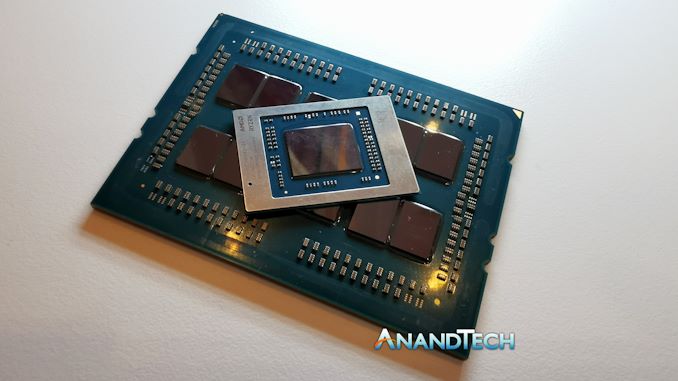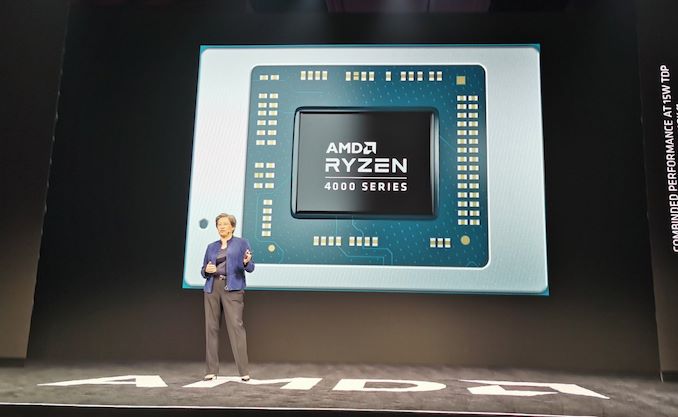AMD Ryzen Mobile 4000: Measuring Renoir’s Die Size
by Dr. Ian Cutress on January 14, 2020 9:00 AM EST- Posted in
- CPUs
- AMD
- Trade Shows
- Ryzen Mobile
- Renoir
- CES 2020
- Ryzen 4000

I’m pretty sure that the next time I go to a trade show where new silicon is being announced, the next tool I need in my backpack is a set of calipers in order to measure the die size. While die size doesn’t in of itself mean much as a number on its own, it is the end result of lots of hard work, focused co-design between silicon engineers and the semiconductor fabs, and ultimately there’s a fine balance between features, die size, performance, power, and at the end of the day, cost. With AMD showcasing the first x86-based 8-core CPU to move into the 15 W power envelope, finding out the die size is one of the elements of our investigation into how AMD has created its new Renoir / Ryzen Mobile 4000 product.
When I first saw the silicon, I wasn’t able to take pictures. Instead, I had to guess the size by manually placing it next to a 8-core Zen 2 chiplet from AMD’s monster 64-core Threadripper 3990X. We’ve known the die size for a while now, at 10.32 x 7.34 mm, or 75.75 mm2. My guess at the time that the new Renoir APU was almost exactly double the Zen 2 chiplet, and I mean it was scary how close to double the size it was. At the time of the announcement of Ryzen Mobile 4000, I had stated in our article that I estimated 150 mm2 for the die size. Turns out, I wasn’t too far wrong.
This image is not to scale.
Later at CES, I went up to the AMD booth and this time they were more than happy for me to take photographs of the new silicon. The 3990X was also there, so I could place the two side by side and get a reasonable reference photograph on which to do calculations. This is the point of the event where I should have remembered to bring calipers! Taking photographs of chips is actually quite hard, making sure you get them lined up perfectly to get the same perspective, but also having enough light to get clear defined silicon edges.
In our picture, the Renoir chiplet you may notice is very slightly angled to the camera, which we’ve compensated for in our measurements.
With that in mind, here are our numbers.
The Zen 2 chiplet on the left, measures 10.32 mm by 7.34 mm, which is a ratio of 1.406 to 1.
In our image, the chiplet measured 265 pixels by 189 pixels, which is a ratio of 1.402 to 1.
In our image, the Renoir SoC measured 282 pixels by 350 pixels, which is a ratio of 0.806 to 1.
If we take the corresponding pixel dimensions, that gives us 10.98 mm by 13.59 mm, a ratio of 0.808 to 1.
This means that the die size of an eight-core Renoir APU with eight 2nd Gen Vega compute units, according to our calculations, 149.27 mm2.
| Die Sizes | ||||||
| AnandTech | x | y | Die Size | Process | Cores | EUs/ CUs |
| AMD Zen 2 Chiplet | 10.32 | 7.34 | 75.75 mm2 | TSMC N7 | 8 | - |
| Intel Ice Lake | 11.44 | 10.71 | 122.52 mm2 | Intel 10 | 4 | 64 |
| Intel Tiger Lake | 13.64 | 10.71 | 146.10 mm2 | Intel 10+ | 4 | 96 |
| AMD Picasso | 19.21 | 10.92 | 209.78 mm2 | GF 12 | 4 | 11 |
| AMD Renoir APU | 13.59 | 10.98 | 149.22 mm2 | TSMC N7 | 8 | 8 |
That’s pretty close to my 150 mm2 estimate, and I’ve also spoken to a few trusted individuals who have been tracking Zen 2 die structure sizes and graphics structure sizes, and they came out very similar, within 1mm2 or so.
At 149.27 mm2, assuming that AMD is achieving the same defect ratio on the silicon as reported by TSMC for the standard N7 process (0.09 defects per cm2), the process yield should be around 90%. Obviously that doesn’t take into account manufacturing for yield, or the distribution of the power/frequency of the chips within a wafer, but it’s still rather impressive.
Before AMD announced this new chip, there was a good deal of speculation as to how AMD would build it: either four cores with more graphics, or with eight cores and graphics only a little better. One factor of that was the die size: at 200 mm2, one would have expected AMD to definitely use eight cores. For sub 125 mm2, in order to maintain GPU performance, perhaps a quad-core design only have been suitable. However, AMD is claiming a great win here: eight Zen 2 cores, with frequencies at 1.8-4.3 GHz at 15 W, and despite fewer graphics compute units (down from 11 to 8), a higher per-compute unit performance claim of +56% means that performance is actually higher. All just shy of 150 mm2.
We are living in the future. I can’t wait for more.
It's worth noting that AMD's official number for the Zen 2 die size is 74 mm2. This is derived from the floorplan of the chip, which during manufacturing has additional space added to ensure clean die seperation between adjacent die prints. Ultimately what we get as the consumer is that seperation lane (known as a scribe lane) from one side of the die to the other, which is just slightly bigger than the floor plan that AMD supplies to the fabrication plant / TSMC. With calipers, what we get is that additional space, which is above AMD's quoted size.












103 Comments
View All Comments
gagegfg - Tuesday, January 14, 2020 - link
"... the clock speeds are absolutely bad to compete with Intel."Core i7-1068G7 Base Freq. "1.3 Ghz" (quad core)
Core i7-1035G7 Base Freq. "1.2 Ghz" (quad core)
Core i7-1035G4 Base Freq. "1.1 Ghz" (quad core)
Core i7-1035G1 Base Freq. "1.0 Ghz" (quad core)
Core i7-1005G1 Base Freq. "1.2 Ghz" (dual core)
I do not think so..............
Korguz - Tuesday, January 14, 2020 - link
man gondalf.. that post makes NO SENSE what so ever.. were you drunk?? high on drugs ?? upset because you beloved intel isnt the leader on desktop.. and may not have an easy win on mobile now ?? your post also is nothing more then an intel shills personal opinion.. with no facts or proof... give it up already...Iolite - Tuesday, January 14, 2020 - link
AMD does not even really need to compete toe to toe with Intel, they just needs to get really close, say 95% of the way. AMD's strategy is to get you almost everything Intel has to offer at 25-50% less at retail. When your talking a gain of 5% to maybe 18% tops better performance with an Intel, pending on chip class, you're paying an additional $75-$150 for it. Add to that the fact AMD it's finally producing similar power consumption, well you can see why AMD shares have been soaring over the last 5 years.However, the edge that Intel once enjoyed for over a decade has quickly shrunk to a single gate. Give AMD'S advancement in the last five years, Intel has got to be more than a little nervous about future market share.
sing_electric - Wednesday, January 15, 2020 - link
Well, put another way, AMD's finally making the same proposition with mobile that it did with desktop Zen's launch (only now they're catching up with IPC): For $X, we'll come close on single-threaded performance but we'll give you a lot more cores for multi-thread.It wouldn't surprise me to see say, Ryzen 7's offered for the same price as an i5, and Ryzen 5's for the same price as an i3.
I'm particularly interested in battery life of these chips, since AMD's finally packing LPDDR4X support, negating a platform advantage Intel's had. (Gut feeling is that AMD will be doing better than before, but Intel still pulls ahead with absolute numbers.)
eek2121 - Tuesday, January 14, 2020 - link
Ian, I feel the need to bring up that the Zen 2 cores technically aren't 'full blooded' as they have less cache. They still should pack quite a punch though, and I look forward to a review.ET - Tuesday, January 14, 2020 - link
Agreed. AMD made something of that 'gamecache'. One would assume that dropping it to a quarter of the size would have a significant effect on 'gamability'.On the other hand, a monolithic die could have lower RAM latency, which might help compensate for this.
I'll be looking forward to some deep investigations into this when the laptops hit the market.
Kevin G - Tuesday, January 14, 2020 - link
I'll third this idea.A monolithic die is an interesting data point even with the change in cache amount.
Spunjji - Wednesday, January 15, 2020 - link
Agreed - memory latency tests and their effect on IPC vs. the desktop cores would be a really interesting avenue of investigation.Plus we'll have some actual figures to shut Gondalf up with :D
Korguz - Wednesday, January 15, 2020 - link
spunjji... wanna bet ?? he will still find some way to counter that with some stupid reason, with no proof.. just to make intel appear better...Smell This - Monday, July 20, 2020 - link
*** G O N D A L F ***